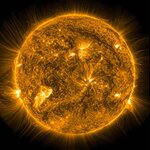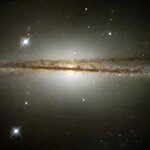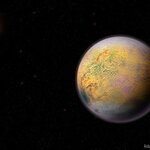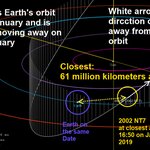Space

UPDATE: 2010 GD37 is now REMOVED from the risk list - it turns out that it's just an ordinary main belt asteroid. 2010 GD37 is now REMOVED from the risk list
Short summary - NASA did not warn about this - it’s only at warning level 0 and has to be 5 or above to be of public concern. The best fit projected orbit takes it to somewhere out beyond Mars's orbit in December, and what's more, at the opposite side of the sun from Earth on that date. But based on only three and a third days of orbit. If it was going to hit then our telescopes should have spotted it by now. In particular, the new ATLAS…

A team of scholars has found that magnetic waves in the Sun’s corona, its outermost layer of atmosphere, react to sound waves escaping from the inside of the Sun.
Alfvénic waves are in plasma and have been found to play a crucial role in transporting energy around the Sun and the solar system. They were previously thought to originate at the Sun’s surface, where boiling hydrogen reaches temperatures of 6,000 degrees and churns the Sun’s magnetic field. However, researchers have found evidence that the magnetic waves also react – or are excited – higher in the atmosphere by sound waves…

From a great distance, our Milky Way would look like a thin disc of stars that rotates once every few hundred million years around its central region. Hundreds of billions of stars provide the gravitational glue to hold it all together.
But the pull of gravity is much weaker in the galaxy’s far outer disc. Out there, the hydrogen clouds that make up most of the Milky Way’s gas disc are no longer confined to a thin plane. Instead, they give the disc an S-like, warped appearance.
Although the Milky Way’s warped hydrogen gas layer had been known for decades, in research published today in Nature…

After two percent of astronomers threw out one arbitrary definition of planet and replaced it with another arbitrary definition of planet, our solar system went from nine planets to eight. Pluto became instead a dwarf planet because the the International Astronomical Union said a planet must have "cleared its neighborhood" of other orbiting bodies and since Pluto did not clean out the entire Kuiper Belt full of asteroids it did not qualify.
NASA did not agree, at least not the experts like the principal investigator of NASA's New Horizons mission which flew by Pluto in 2015, while…
Oumuamua the object which passed through our solar system in October 2017 with a trajectory that indicates it was not of this solar system was never photographed. We only saw a point of light that that changes in brightness as it rotates. There could be many reasons a natural body might change greatly in brightness, trajectory, and velocity as it rotates. In all the randomness of collisions between bodies in the heavens almost anything is possible. However, when it comes to alien life, we have to be careful. No one or two things can give us reasonable…

2002 NT7 is closest at 16.50 today, UTC time. It will be 61 million kilometers away and they know the distance exactly to within 127 kilometers, and the time of the flyby accurate to the nearest minute. It is no risk to Earth.
It is already well above our orbit though, it crossed the orbit of Earth several days ago on the 8th. And 61 million kilometers is further away than Mars at its closest. It is not very close.
Earth's orbit in blue, 2002 NT7 in white.
More details here
Why You Don’t Need To Worry About Asteroid 2002 NT7
I have written this article to help scared people. I continue to…

It actually crossed our orbit already on the 8th. It is already moving upwards away from our orbit. Earth is catching up on it from behind and is closest on the 13th at 61 million kilometers. That's further away than Mars at its closest, and much further away than Venus at its closest.
The red top tabloids and other sensationalist press and YouTube videos are going wild about this, in many different languages too. It is my most often asked question at present from scared people, whether their lives are at risk because of this asteroid. It doesn't matter if they say it or write it in Russian…

For any of you who haven't seen it, here is a stereo image of Ultima Thule, alternating between two images which help if you don’t have 3D Anaglyph glasses. The interesting thing about it is that there is no sign that the two lobes are more than slightly squashed by touching each other. They seem to have formed like this, in a gentle process, as separate objects that gradually grew by gravitational attraction of smaller pieces. Then eventually, the system lost energy probably due to influence of some third moon, and as they came together gently touched each other.
With comets and asteroids…
China has a track record of slow gradual advancement in space flight technology which is unlikely to alarm the US of A into action in the way Sputnik did. The timeline of their advancement suggests no reason to panic about their space program. Their achievement is great. Landing on the far side of the moon (the side which always faces away from the earth is no small feat.) This is a great achievement, but this is not the beginning of a new epoch of history or any such thing.
This is the image taken from China’s probe on the surface of the far side of the Moon. Relayed by a satellite at Earth…

From the Neolithic to present times, the amount of sunlight we see in a day has had a profound impact on human culture. We are fast approaching the winter solstice for the Northern hemisphere, which takes place on December 21. This is the longest night of the year – once celebrated as “Yule” by the pagan people of Northern Europe before it became Christmas.
Stonehenge and the nearby Neolithic site of Durrington Walls (circa 2,500 BC) were each built to be orientated to face the midwinter sunset and sunrise respectively. This focus on the winter solstice was an important time marked by…